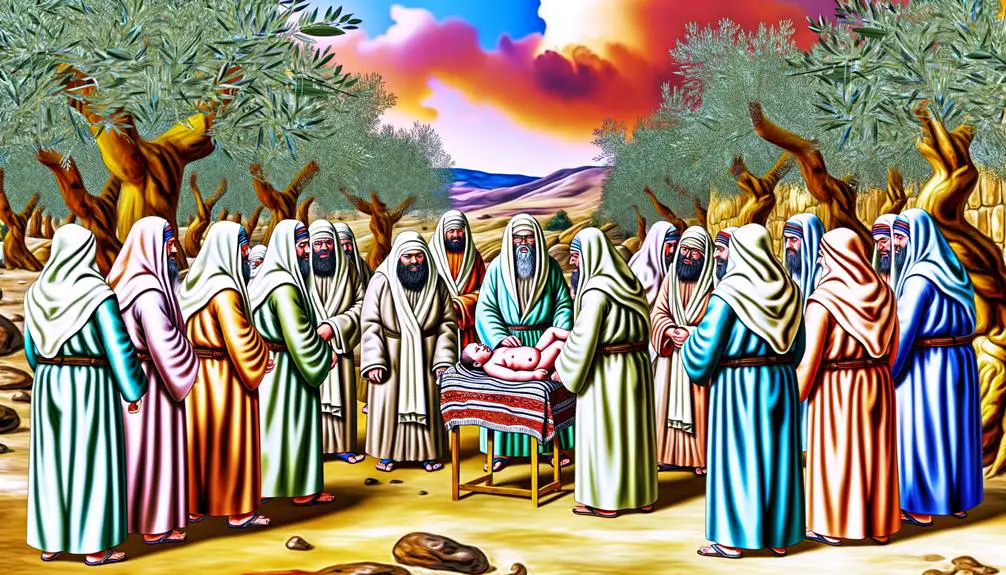Navigate the profound layers of circumcision in the Bible, a symbol of faith, identity, and divine covenant—discover its evolving significance.

Circumcision Meaning in the Bible
In the Bible, you'll find that circumcision is not merely a physical act; it signifies a deep, covenantal bond initiated by God with Abraham, as noted in Genesis 17. This ritual, adopted from Egyptian practices, became a critical marker of faith and identity in Jewish tradition. Performed on the eighth day after a male child's birth, as outlined in Leviticus 12, it symbolizes purity, obedience, and a committed relationship with God. Over time, its meaning evolves—particularly in the New Covenant, where it symbolizes a 'circumcision of the heart.' Understanding these layers will enhance your grasp of its multifaceted significance.
Key Takeaways
- Circumcision in the Bible symbolizes a covenant between God and Abraham's descendants.
- It serves as a sign of faith, obedience, and belonging to the Jewish community.
- Originally mandated on the eighth day after birth, reflecting divine command and health wisdom.
- In the New Testament, circumcision is seen as a metaphor for spiritual purification.
- Paul advocates for a "circumcision of the heart," emphasizing spiritual commitment over physical ritual.
Origins of Biblical Circumcision

In examining the origins of biblical circumcision, it's important to observe that this practice was established as a covenant between God and Abraham, detailed in Genesis 17. However, the roots and influences of this ritual extend far beyond this singular narrative, intertwining with the broader historical and cultural contexts of the ancient Near East, particularly Egypt.
Scholars such as K.J. Thomas (1991) have argued that Egyptian influences were paramount in shaping early Hebrew practices, including circumcision. The Egyptians practiced circumcision as a rite of passage for young males, a tradition that might have been observed by neighboring cultures, including the Hebrews, due to close geographical and cultural interactions (Thomas, 1991). This perspective is significant as it highlights how circumcision was not solely a religious act but part of a larger cultural diffusion process.
Furthermore, health rationales have also been speculated to play a role in the adoption of circumcision among ancient communities. Researchers like Zias (1988) suggest that in arid climates, where hygiene could be challenging, circumcision might have offered practical health benefits, such as reduced risk of infections and other complications (Zias, 1988). This utilitarian aspect may have contributed to its incorporation into religious and cultural norms, making it a multifaceted practice with both spiritual and pragmatic dimensions.
Covenant With Abraham
Central to the narrative of Genesis 17, God's covenant with Abraham marks a pivotal moment where circumcision was established as a symbol of faith and obedience within the Hebrew community. This covenant isn't merely a ritualistic practice; it's a profound declaration of a divine promise that connects individual faith to the continuity of familial lineage.
Consider these key aspects:
- Divine Promise: The covenant is fundamentally a divine promise from God to Abraham. It signifies an unbreakable bond, where God commits to making Abraham the father of many nations and to bless his descendants (Gen 17:2).
- Sign of the Covenant: Circumcision serves as a tangible sign of this covenant. It's a physical manifestation of Jewish identity and a perpetual reminder of their special relationship with God.
- Familial Lineage: The act of circumcision is deeply tied to familial lineage, ensuring that every male descendant of Abraham bears a mark of their inclusion in God's covenant, thereby perpetuating the bond through generations (Gen 17:9-10).
- Faith and Obedience: By accepting circumcision, Abraham and his descendants demonstrate their faith and obedience to God's commands, reinforcing their commitment to uphold the covenant.
Each of these elements showcases how circumcision transcends its physical act, embodying a spiritual and communal ethos that has defined and directed the Hebrew faith across centuries.
Rituals and Regulations

Circumcision's detailed rituals and stringent regulations, outlined primarily in Leviticus 12, exemplify its critical role in maintaining purity and obedience within the community. You'll find that these practices are not merely ceremonial but are laden with deep theological significance and practical considerations, including health implications.
The procedure, traditionally performed on the eighth day after a male child's birth, intertwines with cultural adaptations and evolving medical insights. Historically, the timing has been linked to peak immune system functionality, which underscores the blend of divine command and inherent health wisdom (Schnieder, 2004).
Here's a breakdown of the key elements related to circumcision's rituals and regulations:
Aspect |
Biblical Reference |
Contemporary Significance |
|---|---|---|
Timing |
Leviticus 12:3 |
Aligns with medical insights for immunity |
Purification |
Leviticus 12:6-8 |
Emphasizes spiritual and physical cleanliness |
Priest Role |
Leviticus 12:6 |
Mediator of divine and communal standards |
Cultural Adaptation |
Genesis 17:9-14 |
Adjustments in practice across cultures |
This table helps you understand how ancient prescriptions translate into current practices, revealing an adaptive tradition that respects both divine commands and evolving cultural contexts. Therefore, circumcision in the biblical sense serves as a bridge between faith, health, and cultural identity.
Circumcision in Jewish Law
In examining the role of circumcision within Jewish law, you'll find its origins deeply rooted in the Torah, specifically in the Covenant of Abraham. This covenant, as recorded in Genesis 17, mandates circumcision as a perpetual sign of the agreement between God and Abraham's descendants. Scholars argue that this practice not only signifies belonging to the Jewish faith but also serves as a critical rite of passage within the community (Feldman, 2011).
Origin in Torah
The Torah mandates circumcision as a covenantal sign between God and Abraham's descendants, as detailed in Genesis 17. This ancient practice, deeply embedded in cultural and religious identity, extends beyond mere tradition; it intersects meaningfully with health implications and broader cultural practices. As you explore its origins, consider its multifaceted impact:
- *Hygienic Benefits*: Historical views suggest a reduction in certain medical conditions.
- *Cultural Integration*: Serves as a rite of passage within the community.
- *Legal Adherence*: Fulfillment of religious law as prescribed in Jewish texts.
- *Social Identity*: Marks an individual's belonging and commitment to their faith.
Understanding these aspects provides deeper insight into why circumcision holds such a pivotal role in Jewish life and beyond.
Covenant of Abraham
Delving into the Covenant of Abraham, it's evident that circumcision is not merely a physical act but a profound manifestation of Jewish legal and spiritual commitment. This rite symbolizes an everlasting covenant between God and Abraham's lineage, as detailed in Genesis 17. Here, God promises Abraham numerous descendants and the lands of Canaan, contingent on circumcision as a perpetual sign of this bond (Gen. 17:10-14).
Your understanding is deepened by recognizing that this act transcends mere tradition; it's a legal obligation and a divine mandate that connects you, as one of the Abrahamic descendants, to those genealogical promises. This ritual enshrines your identity in continuity with a historic, covenantal lineage, underscoring its enduring significance in Jewish life and law.
Spiritual Symbolism

Circumcision's spiritual symbolism within Biblical texts represents a covenant between God and His followers, reflecting a profound transformation of the heart and spirit. This act is not just a physical alteration but is imbued with deep spiritual significance, suggesting heart purification and symbolic renewal.
- Covenantal Sign: Circumcision is a sign of the covenant between God and Abraham (Genesis 17:10-14), symbolizing a lifelong commitment to faith and obedience. It's not merely a ritual but a signifier of belonging to God's chosen people.
- Heart Purification: The procedure symbolizes the purification of the heart, an inner circumcision that reflects a rejection of impurity and an embrace of a sanctified life (Deuteronomy 10:16). This spiritual cleansing is critical to forming a deeper relationship with God.
- Symbolic Renewal: By undergoing circumcision, individuals symbolically shed their former selves and renew their commitment to God. This renewal is an ongoing process of spiritual growth and moral improvement.
- Moral Imperative: The act serves as a constant reminder of the moral and ethical standards expected from the followers of God, aligning their actions with divine laws and principles.
Understanding these layers adds depth to the physical act, highlighting its enduring spiritual and moral implications.
New Testament Perspectives
In examining New Covenant teachings, it's evident that circumcision is no longer viewed merely as a physical requirement but as a metaphor for spiritual purification and commitment to God. Paul's teachings particularly underscore this shift. In his letters, Paul argues that physical circumcision is of no value in Christ Jesus (Galatians 5:6). Instead, he promotes the concept of a 'circumcision of the heart' by the Spirit (Romans 2:29), which signifies internal spiritual renewal rather than external conformity to ritual.
This theological reorientation is closely linked with Gentile inclusion. Paul's stance facilitated the integration of Gentiles into the early Christian community without the barrier of Jewish ritual law, emphasizing faith in Christ as the new covenant's true mark (Ephesians 2:11-22). This inclusivity is a key aspect of Paul's mission, as he sought to establish a faith community based on spiritual unity rather than ethnic or cultural similarity.
Thus, in the New Scripture perspective, circumcision transcends its physical origins, becoming a symbol of one's inner commitment to the teachings and spirit of Christ. This interpretation not only broadened the scope of Christian fellowship but also redefined the markers of religious identity in the early Church.
Modern Interpretations and Debates

When we reflect on the current discussions surrounding circumcision, it is important to acknowledge how interpretations have evolved since the early Church's debates. The dialogue has shifted considerably, integrating both theological reflections and contemporary concerns such as health implications and cultural adaptation.
Here's a quick roundup of the key considerations in modern debates on circumcision:
- Health Implications: Contemporary research often discusses the medical benefits and risks associated with circumcision. Studies such as those by the WHO have cited reductions in certain infections, yet others point to the surgical risks involved (WHO, 2007).
- Cultural Adaptation: As societies become more multicultural, the practice of circumcision is often examined through the lens of cultural identity and adaptation. This involves a delicate balance between respecting traditional practices and adapting to new societal norms.
- Ethical Concerns: Modern debates increasingly consider the ethics of performing circumcision, especially on infants who cannot consent. The discussion often revolves around bodily autonomy and human rights (AAP, 2012).
- Religious Significance: While some religious groups see circumcision as a covenantal act, others question its relevance in contemporary spiritual life, sparking debates about religious obligation versus personal choice (Johnson, 2015).
These points highlight the complexity of circumcision as not just a biblical command but as a practice influenced by a variety of contemporary factors.
Frequently Asked Questions
How Do Different Christian Denominations View Circumcision?
Different Christian denominations have varied perspectives on circumcision, influenced by historical origins and denominational rituals. It's seen as a cultural tradition rather than a theological mandate, with practices varying widely among groups.
Is Circumcision Mandatory for Salvation in Christianity?
In Christianity, circumcision isn't mandatory for salvation. Salvation theology emphasizes faith and grace rather than physical rituals. Covenant symbolism, while important, shifts from physical acts to spiritual commitment in New Covenant teachings.
Can Circumcision Affect Spiritual Growth or Awareness?
Circumcision itself won't directly impact your spiritual growth or awareness. It's more about the covenant significance and spiritual symbolism in your beliefs rather than a physical act influencing spiritual development.
How Do Contemporary Jewish Communities Practice Circumcision?
In contemporary Jewish communities, over 90% of male infants undergo circumcision, maintaining deep-rooted ceremony traditions. This practice shapes community perceptions, emphasizing continuity and identity within a rich historical and cultural framework.
What Are Ethical Concerns Regarding Circumcision in Modern Times?
You may find ethical concerns about circumcision center on medical implications and cultural pressures. Scholars debate its necessity, citing potential health risks and questioning whether cultural norms justify such an irreversible procedure.



Sign up